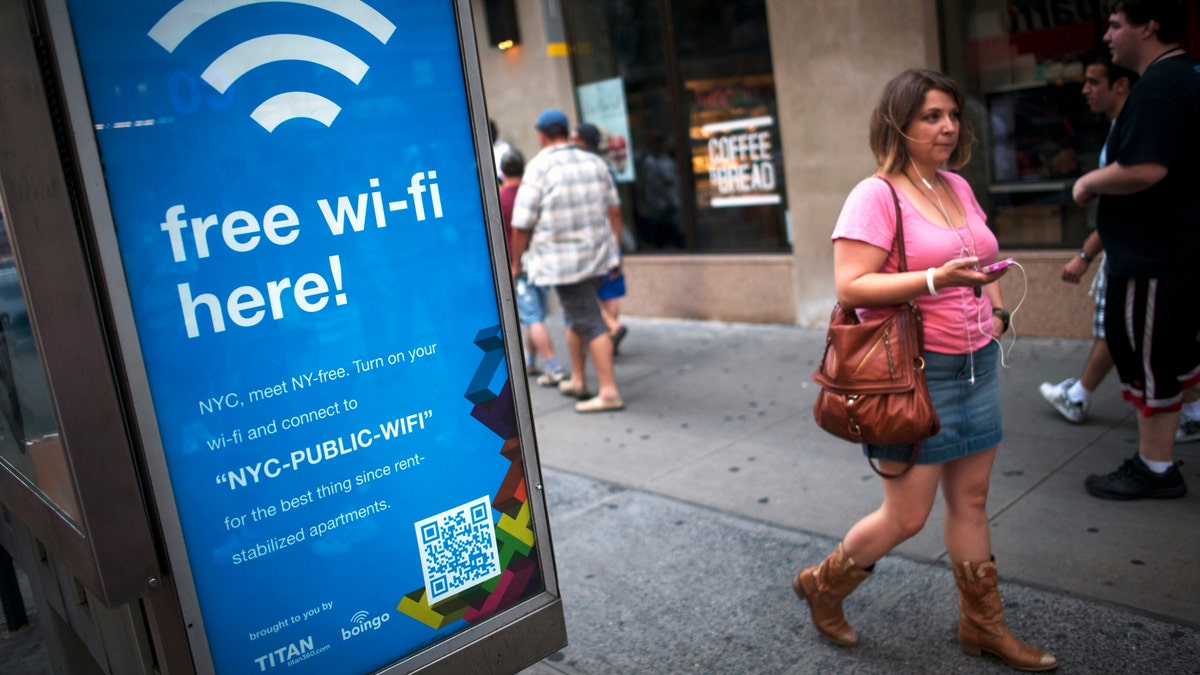
A woman walks past a WiFi-enabled phone booth in New York. (REUTERS/Keith Bedford)
When you're on the go and running out of data on your cellular plan, finding free public Wi-Fi is like getting a fantastic present on Christmas morning
But unlike a Christmas present, free public Wi-Fi comes with a cost. No, not your firstborn child (although some people in London agreed to do just that). I'm talking about security.
You can find free Wi-Fi hotspots everywhere, and you can even scout them out before you travel using an app like Free Wi-Fi Finder. Just keep in mind that crooks have several ways to snag your information when you’re using a Wi-Fi hotspot. I'm going to tell you three of the most popular methods, and how to protect yourself.
1. Honeypot Wi-Fi networks
Most free Wi-Fi comes courtesy of a coffee shop or hotel. (See if your prospective hotel has fast Wi-Fi.) But that free network might actually be a hacker-run router.
Hackers have no problem setting up a router in a public area and naming it something like "coffee shop Wi-Fi" or "free hotel Wi-Fi." It might even use the name of a business in the area. Plenty of people will connect without thinking.
Even worse, a hacker might set up next to a legitimate Wi-Fi network and give his network the same name. Even if you spot the duplication in the network list, you won't know which one is safe.
Once you connect to the hacker's network, he can start probing your gadget for weaknesses and slip in viruses or spy on your browsing. He can also redirect your browsing so you end up on malicious websites.
How do you stay safe? Well, staying off public Wi-Fi is the safest option, but that kind of misses the point. Instead, make sure you check with the business you're visiting to verify the name of the Wi-Fi network – many places will require you to get a password anyway.
Then, make sure you scroll through the list of networks in the area. If you spot more than one with the same name, let the business know. In most cases, it will be because the business has a dual-band Wi-Fi router that creates two networks – one at 2.4Ghz and one at 5Ghz. You can't be too careful, though.
Make sure your gadget's operating system is up to date, along with the browser (see if your browser needs updating) and security software. That way, there won't be holes for hackers to exploit.
You can also grab a VPN app to encrypt your Internet connection. That way, hackers won't be able to snoop on what you're sending and receiving. Click here for a popular VPN and other ways to keep info thieves off your gadget.
2. Packet sniffing
Of course, you don't have to connect to hackers' routers for them to snoop. Being on the same legitimate network is enough to cause trouble, thanks to packet sniffing.
When you send and receive data over the Internet, the information is sent in millions of tiny packets. Hackers use packet sniffers to intercept these packets and read them to see what you're doing.
That includes snagging usernames and passwords, reading your email, texts or social media posts and seeing what sites you're visiting. This takes some tweaked hardware and special software, but it isn't anything a halfway competent hacker can't put together.
To protect yourself, you can use a VPN app or site to create an encrypted connection, as I mentioned above. You'll also want to avoid visiting important sites, such as banking sites, on public Wi-Fi.
If you must bank on the go, use the bank's app on your smartphone or tablet over a cellular connection. Click here for the most critical steps you need to take for secure online banking.
3. Shared folders
Most people use Wi-Fi networks to access the Internet, and it's easy to forget that the whole point of networking is to share information among computers or gadgets on the same network.
If your gadget is set to share folders automatically, then anyone – not just a hacker – can see what you're sharing.
Fortunately, Windows Vista, 7 and 8 make it simple to automate your sharing settings. When connecting to a public hotspot for the first time, Windows asks for a location type. Make sure you set it to "public." This will automatically modify sharing settings for maximum safety.
On a Mac, go to System Preferences>>Sharing and make sure all the sharing boxes are unchecked. You'll have to turn on the controls again when you want to share files on your home or work network.
For now, you don't really need to worry about this on a smartphone or tablet.
Of course, it works the other way. An enterprising hacker or prankster might share a "honeypot" folder on a public network. If your computer is connected, you might see it under your "shared" folders and be fooled into opening it.
Let's say a hacker names a file "sexyphoto.jpg" or "diary.txt" – you know some people are going to open them. But they could actually be viruses in disguise that infect your computer.
When it comes to file sharing on public Wi-Fi, the rule is: Share nothing and don't be nosy.
I said in the beginning that these were the three most popular ways hackers attack. Click here to learn even more ways to stay safe when using public Wi-Fi.
On the Kim Komando Show, the nation's largest weekend radio talk show, Kim takes calls and dispenses advice on today's digital lifestyle, from smartphones and tablets to online privacy and data hacks. For her daily tips, free newsletters and more, visit her website at Komando.com. Kim also posts breaking tech news 24/7 at News.Komando.com.




















